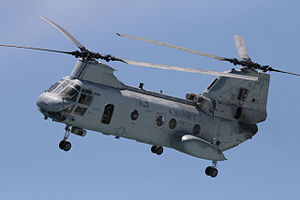
The Boeing Vertol CH-46 Sea Knight is a medium-lift tandem rotor transport helicopter powered by twin turboshaft aircraft engines. It was used by the United States Marine Corps (USMC) to provide all-weather, day-or-night assault transport of combat troops, supplies and equipment until it was replaced by the MV-22 Osprey. Additional tasks included combat support, search and rescue (SAR), support for forward refueling and rearming points, CASEVAC and Tactical Recovery of Aircraft and Personnel (TRAP).
The Sea Knight was also the United States Navy's standard medium-lift utility helicopter until it was phased out in favor of the MH-60S Knighthawk in the early 2000s. Canada also operated the Sea Knight, designated as CH-113, and operated them in the SAR role until 2004. Other export customers include Japan, Sweden, and Saudi Arabia. The commercial version is the BV 107-II, commonly referred to simply as the "Vertol".
Piasecki Helicopter was a pioneering developer of tandem-rotor helicopters, with the most famous previous helicopter being the H-21 "Flying Banana". Piasecki Helicopter became Vertol in 1955 and work began on a new tandem rotor helicopter designated the Vertol Model 107 or V-107 in 1956. The V-107 prototype had two Lycoming T53 turboshaft engines, producing 877 shp (640Â kW) each.